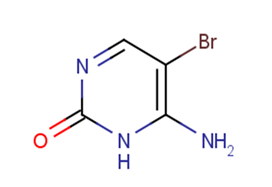
5-Bromocytosine
CAS No. 2240-25-7
5-Bromocytosine( —— )
Catalog No. M20863 CAS No. 2240-25-7
5-Bromocytosine can be used in the synthesis of cross-link products under anaerobic and aerobic conditions.
Purity : >98% (HPLC)
 COA
COA
 Datasheet
Datasheet
 HNMR
HNMR
 HPLC
HPLC
 MSDS
MSDS
 Handing Instructions
Handing Instructions
| Size | Price / USD | Stock | Quantity |
| 5MG | 42 | In Stock |


|
| 10MG | 67 | In Stock |


|
| 25MG | 140 | In Stock |


|
| 50MG | 205 | In Stock |


|
| 100MG | 309 | In Stock |


|
| 500MG | 734 | In Stock |


|
| 1G | Get Quote | In Stock |


|
Biological Information
-
Product Name5-Bromocytosine
-
NoteResearch use only, not for human use.
-
Brief Description5-Bromocytosine can be used in the synthesis of cross-link products under anaerobic and aerobic conditions.
-
Description5-Bromocytosine can be used in the synthesis of cross-link products under anaerobic and aerobic conditions.
-
In Vitro——
-
In Vivo——
-
Synonyms——
-
PathwayOthers
-
TargetOther Targets
-
RecptorOthers
-
Research Area——
-
Indication——
Chemical Information
-
CAS Number2240-25-7
-
Formula Weight190
-
Molecular FormulaC4H4BrN3O
-
Purity>98% (HPLC)
-
SolubilityDMSO:9mg/mL(47.37mM)
-
SMILESNc1[nH]c(=O)ncc1Br
-
Chemical Name——
Shipping & Storage Information
-
Storage(-20℃)
-
ShippingWith Ice Pack
-
Stability≥ 2 years
Reference
1.Hong Wang H . Formation of intrastrand cross-link products between cytosine and adenine from UV irradiation of d((Br)CA) and duplex DNA containing a 5-bromocytosine[J]. Journal of the American Chemical Society 2005 127(40):13969-77.
molnova catalog



related products
-
MPO
MPO is a hatch and growth of Caenorhabditis Elegans inhibitor.
-
UPF 1069
UPF 1069 is a specific PARP2 inhibitor ( IC50: 0.3 μM). It is ~27-fold selective against PARP1.
-
4-Hydroxychalcone
4-Hydroxychalcone attenuates hyperaldosteronism, inflammation, and renal injury in cryptochrome-null mice.



 Cart
Cart
 sales@molnova.com
sales@molnova.com


